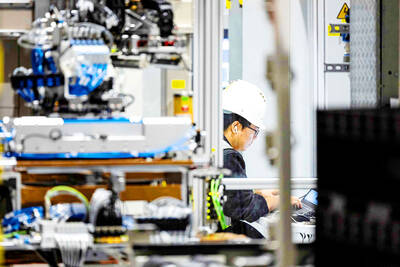US stocks rose after a report showing the economy added jobs for the first time in seven months fueled confidence in an earnings rebound.
The Dow Jones Industrial Average finished higher for a fourth week, its longest winning streak since May.
"Employment was the missing piece of the puzzle," said Richard Sichel, who oversees US$600 million as chief investment officer at Philadelphia Trust Co. He expects companies will start raising profit forecasts "in a few weeks."
He is buying Wells Fargo & Co and American Home Products Corp shares.
International Business Machines Corp, Microsoft Corp and Intel Corp accounted for more than half the Dow's gain after Merrill Lynch & Co advised investors to buy technology shares.
The NASDAQ Composite Index rose 48.04, or 2.6 percent, to 1,929.67. The Standard & Poor's 500 Index climbed 6.77, or 0.6 percent, to 1,164.31. The Dow Jones Industrial Average gained 47.12, or 0.5 percent, to 10,572.49.
The Dow gained 2 percent for the week, extending its year-to-date advance to 5.5 percent. The S&P 500 rallied 2.9 percent, erasing the benchmark's loss for the year.
The NASDAQ rose 7 percent, paring its year-to-date decline to 1.1 percent. It was down 12 percent as recently as two weeks ago.
The US stopped losing jobs in February, the Labor Department reported. Payrolls rose by 66,000, after dropping 126,000 in January and 106,000 in December. Unemployment fell to 5.5 percent from 5.6 percent.
The data came a day after Federal Reserve Chairman Alan Greenspan told Congress a recovery is "well under way."
Treasuries dropped for a seventh day, the longest slide in almost a decade for the benchmark 10-year Treasury note, on concern inflation may quicken as demand recovers. The yield on the 10-year note rose 10 basis points to 5.32 percent. Bond prices fall as yields rise.
"It's tough to argue against" an economic rebound, said Joe Balestrino, whose US$290 million Federated Stock and Bond Fund this week shifted money to stocks from bonds for the first time in two years. "We are bottoming right now from a corporate earnings perspective and have already bottomed from an economic perspective."
About 1.4 billion shares traded on the New York Stock Exchange, 3.2 percent more than the three-month daily average.
Advancing and declining stocks were about even on the Big Board, while almost two rose for every one that fell on the NASDAQ Stock Market.
Sun Microsystems, whose server computers run corporate networks and Web sites, gained US$1.17 to US$10. The company reiterated forecasts that fiscal third-quarter revenue will rise "slightly" from last quarter's US$3.11 billion.
IBM, the biggest computer maker, gained US$1.38 to US$105.09.
Cisco Systems Inc., the largest maker of equipment to direct Internet traffic, gained US$0.80 to US$17.80. Intel, the biggest chipmaker, rose US$1.19 to US$34.17.
Microsoft led software companies higher. The biggest software maker rose US$1.23 to US$63.95, Oracle Corp advanced US$0.20 to US$14.20 and Veritas Software Corp rose US$1.26 to US$44.41.
Merrill strategist Steven Milunovich reversed a call he made two months ago that technology stocks were too expensive and should be avoided. Today, he said "increasing signs of a bottom" in technology businesses and reports showing improvement in the overall economy have changed investor sentiment.
Companies in the S&P 500 trade at an average of 23 times next year's earnings estimates, 50 percent above the historical average of 15. At its March 2000 peak, the index traded at 26 times profit forecasts for the next 12 months.
"We're always concerned with valuations, but if earnings pick up, then prices will seem more reasonable," Philadelphia Trust's Sichel said.
General Electric Co, which led indexes higher earlier in the day, fell US$0.35 to US$40.60. The largest company by market value said it had US$43 billion in assets in so-called special-purpose entities. SPE's were used by bankrupt energy trader Enron Corp to keep billions of dollars in liabilities from appearing on its balance sheet.
Qualcomm Inc rose US$2.36 to US$43.80. The Chinese government ordered mobile-phone makers to increase production of handsets to expand the use of a new wireless network based on technology developed by Qualcomm.
Schlumberger Ltd led a decline in oil-service companies as crude fell on expectations for easing tensions in the Persian Gulf. The world's biggest oilfield-services company lost US$2.21 to US$58.14.
Smith International Inc dropped US$2.25 to US$64.53.
Financial companies gained as investors anticipated the renewed economic growth would increase lending and curb defaults.
Morgan Stanley Dean Witter & Co climbed US$1.64 to US$56.86, JP Morgan Chase & Co rose US$0.69 to US$34.74 and American Express Co rallied US$0.96 to US$40.47.
Biogen Inc dropped US$4.75 to US$51.65. Serono SA won US approval for the multiple sclerosis drug Rebif, threatening sales of Biogen's Avonex. Serono's US shares jumped US$2.62 to US$22.21.

CHIP RACE: Three years of overbroad export controls drove foreign competitors to pursue their own AI chips, and ‘cost US taxpayers billions of dollars,’ Nvidia said China has figured out the US strategy for allowing it to buy Nvidia Corp’s H200s and is rejecting the artificial intelligence (AI) chip in favor of domestically developed semiconductors, White House AI adviser David Sacks said, citing news reports. US President Donald Trump on Monday said that he would allow shipments of Nvidia’s H200 chips to China, part of an administration effort backed by Sacks to challenge Chinese tech champions such as Huawei Technologies Co (華為) by bringing US competition to their home market. On Friday, Sacks signaled that he was uncertain about whether that approach would work. “They’re rejecting our chips,” Sacks

It is challenging to build infrastructure in much of Europe. Constrained budgets and polarized politics tend to undermine long-term projects, forcing officials to react to emergencies rather than plan for the future. Not in Austria. Today, the country is to officially open its Koralmbahn tunnel, the 5.9 billion euro (US$6.9 billion) centerpiece of a groundbreaking new railway that will eventually run from Poland’s Baltic coast to the Adriatic Sea, transforming travel within Austria and positioning the Alpine nation at the forefront of logistics in Europe. “It is Austria’s biggest socio-economic experiment in over a century,” said Eric Kirschner, an economist at Graz-based Joanneum

BUBBLE? Only a handful of companies are seeing rapid revenue growth and higher valuations, and it is not enough to call the AI trend a transformation, an analyst said Artificial intelligence (AI) is entering a more challenging phase next year as companies move beyond experimentation and begin demanding clear financial returns from a technology that has delivered big gains to only a small group of early adopters, PricewaterhouseCoopers (PwC) Taiwan said yesterday. Most organizations have been able to justify AI investments through cost recovery or modest efficiency gains, but few have achieved meaningful revenue growth or long-term competitive advantage, the consultancy said in its 2026 AI Business Predictions report. This growing performance gap is forcing executives to reconsider how AI is deployed across their organizations, it said. “Many companies

France is developing domestic production of electric vehicle (EV) batteries with an eye on industrial independence, but Asian experts are proving key in launching operations. In the Verkor factory outside the northern city of Dunkirk, which was inaugurated on Thursday, foreign specialists, notably from South Korea and Malaysia, are training the local staff. Verkor is the third battery gigafactory to open in northern France in a region that has become known as “Battery Valley.” At the Automotive Energy Supply Corp (AESC) factory near the city of Douai, where production has been under way for several months, Chinese engineers and technicians supervise French recruits. “They